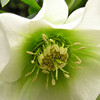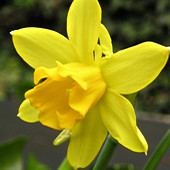5 March 2003
Been a marvellous week of tackling various springtime jobs out in the garden, where spring seems to have arrived, certainly the wildlife thinks so. At dusk each day birds sing and call from all the gardens around. The resident blackbirds are building a nest in the ivy by the gate, and frogs have reappeared this week in the small garden pond. Bright green growth has sprung, magically, from the dry brown tangles of clematis.
It's been damp and mild weather, but before the rain I was lucky enough to have enough time free to take advantage of the dried-out ground, in perfect condition for planting the various things I needed to relocate. The soil being on the heavy side, I avoid walking on it when it's wet.
I've tackled a crucial early spring task of taking all the potted hostas from their pots, removing the slugs that hide in the bottom and the eggs they've invariably laid, and repotting the plants in fresh compost. I've always mulched the tops of the pots with coarse grit to deter slugs and snails, but this year I'm trying pine needles, from our discarded Christmas tree.
It was satisfying to be recycling something as apparently useless and irritating as pine needles from the Christmas tree. Similarly satisfying was feeding some vine weevil larvae I found in my potted hostas to the birds. My initial reaction was to squash the little buggers, but this would have been wasteful. There is always something somewhere that wants what you don't want.
So, hostas repotted, vine weevil larvae fed to the birds, pine needle mulch on top of the pots, I lined up my hosta pots so I could congratulate myself on a job well done, while having a cup of tea and a cigarette. The number of pots of hostas has increased over the years, as I've split the biggest clumps and even been able to give some away. They look so fragile in leaf, so much in need of protection from slugs, but underneath the ground they're tough old things with those great thuggish rootstocks. Vine weevil larvae can chew away at the roots for months, and still the hostas seem to have enough root left in there to keep them going.
Aside from the welcome sight of the female blackbird carrying huge beakfuls of nesting material into the ivy on the garden wall, there have been many other garden birds putting in an appearance this week. The sparrows and pigeons are always around, blue tits and goldfinches too. A solitary dunnock has become quite tame, and calls daily for food. The dunnock, despite being a rather drab-looking creature at first glance, is a lovely bird when watched closely, and has a fine melodic song in the springtime. Most welcome in this last week were a pair of song thrushes, quite rare around here. One of the rare occasions I saw one in the garden it was in the grip of a sparrowhawk, and so seeing two thrushes hopping about in the garden unencumbered by birds of prey was a cheering sight. They are though often chased off by the resident male blackbird.
There's a big heap of prunings just outside the window, as I've been
all round the garden trimming ivy and pruning the rampant Parthenocissus
quinquefolia, which needs to be monitored as it keeps trying to creep
under the slates on the roof of the outhouse. The climbing rose Mme
Alfred Carriere is on the same wall, now, after some years, right
up to the height of the bathroom window. As bathroom refurbishment is
now underway, I've tried to train this rose around the bathroom window,
thinking that it would be nice to be able to smell the roses while lying
in the bath. Looking at the bathroom at present, with wallpaper only partly
stripped from the walls, large holes in the floorboards, a rather wonky
sink, a bath with the side panel hanging off, I've got this nightmare
vision that it will still be like that in June when the roses are blooming.
(Note added, February 2004 - it was like that while the roses were blooming
and for some time after - until December, in fact!)
24 March 2003
A lot to catch up on. It's been great gardening weather, but at the times I've made contact with my garden it's mainly been standing staring at it in contemplative fashion, or actually sitting in it in the sunshine, reading a book, as I did yesterday. Not bad to be able to do this - without wearing a coat and gloves - in March, in Yorkshire.
Iris flower after 3 year wait . . .
The winter-flowering iris - Iris unguicularis - that I planted about 3 years ago has been only a small clump of grassy leaves. Each winter I've looked at it hopefully every now and then, wondering if it will ever flower. I know it needs a dry and sunny position, so it's in the driest and sunniest place in the garden, but I wondered if it just didn't like Yorkshire. I couldn't dig it up just for not flowering, so I just ignored it when, once again, it didn't flower in the winter.
Instead it flowered on the first day of Spring, with this fantastic intricately-veined pale purple flower that appeared out of nowhere. It was only one flower, but it chose its moment well.
Frogs in a clinch
The occasional nocturnal wander in the garden with a torch has revealed that there have been three frogs in the pond this month. Two of them have been getting better acquainted. I did think at first that the two heads close together at the edge of the pond might just be two frogs trying to climb out of the pond at the same time - I've been eager to see signs of imminent frogspawn, so might be turning an innocent acquaintance into a full-on frog mating. I then realised that the two frogs might not like having a torch shone in their faces while I was trying to decide.
This seemed to be happening for several nights in a row. The third frog was hanging about on his or her lonesome, at the other end of the pond. I thought this was a bit sad, until I realised that all the frogs looked the same and that they were probably swapping over when I wasn't looking, possibly having great parties and dancing on the lily-pads, then as soon as I go out there with my torch they just do that "hanging around listlessly in the pond doing nothing much" thing, just to fool me.
Well, that's enough anthropomorphism for one day.
Dawn and dusk chorus and other sounds
There are song thrushes around now, not seen much in the neighbourhood of my garden in previous years. They and the robins and the blackbirds and the dunnocks all sing melodically at dusk and at dawn. Other birds do excited rowdy mating calls every now and then from the branches of the trees. The sparrows chatter constantly.
Back to March highlights and diaries


